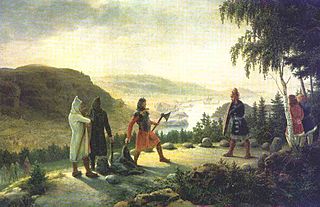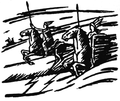
In Norse mythology, Rán is a goddess and a personification of the sea. Rán and her husband Ægir, a jötunn who also personifies the sea, have nine daughters, who personify waves. The goddess is frequently associated with a net, which she uses to capture sea-goers. According to the prose introduction to a poem in the Poetic Edda and in Völsunga saga, Rán once loaned her net to the god Loki.

In Norse mythology, Valhalla is a majestic, enormous hall located in Asgard, ruled over by the god Odin. Chosen by Odin, half of those who die in combat travel to Valhalla upon death, led by valkyries, while the other half go to the goddess Freyja's field Fólkvangr. In Valhalla, the dead join the masses of those who have died in combat, known as Einherjar, and various legendary Germanic heroes and kings, as they prepare to aid Odin during the events of Ragnarök. Before the hall stands the golden tree Glasir, and the hall's ceiling is thatched with golden shields. Various creatures live around Valhalla, such as the stag Eikþyrnir and the goat Heiðrún, both described as standing atop Valhalla and consuming the foliage of the tree Læraðr.
In Norse mythology, Élivágar are rivers that existed in Ginnungagap at the beginning of the world. The Prose Edda relates:
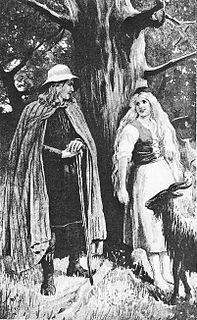
Halga, Helgi, Helghe or Helgo was a legendary Danish king living in the early 6th century. His name would in his own language (Proto-Norse) have been *Hailaga.
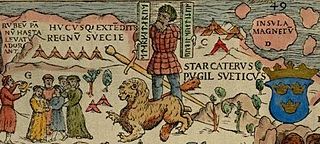
Starkad was a legendary hero in Norse mythology.
Helge or Helgi is a Scandinavian, German, and Dutch mostly male name.

Völsungakviða, Helgakviða Hundingsbana I or the First Lay of Helgi Hundingsbane is an Old Norse poem found in the Poetic Edda. It constitutes one of the Helgi lays together with Helgakviða Hundingsbana II and Helgakviða Hjörvarðssonar.

Völsungakviða in forna, Helgakviða Hundingsbana II or the Second Lay of Helgi Hundingsbane is an Old Norse poem found in the Poetic Edda. It constitutes one of the Helgi lays together with Helgakviða Hundingsbana I and Helgakviða Hjörvarðssonar.
The name Sigar can refer to three people in Scandinavian mythology, surrounding the legends of Sigurd the dragon slayer. One of them only appears as the friend of Helgi Hjörvarðsson in the eddic lay Helgakviða Hjörvarðssonar. The other two appear as the villainous members of the same clan in several sources.

Sinfjötli or Fitela in Norse mythology was born out of the incestuous relationship between Sigmund and his sister Signy. He had the half-brothers Sigurd, Helgi Hundingsbane and Hamund.
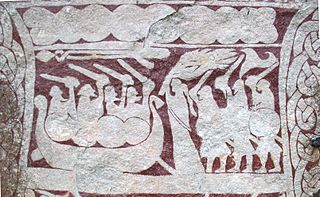
Hjaðningavíg, the legend of Heðinn and Hǫgni or the Saga of Hild is a Scandinavian legend from Norse mythology about a never-ending battle which is documented in Sörla þáttr, Ragnarsdrápa, Gesta Danorum, Skíðaríma and in Skáldskaparmál. It is also held to appear on the image stone at Stora Hammar on Gotland. Moreover, it is alluded to in the Old English poems Deor and Widsið, and in the Old Norse Háttalykill inn forni, and a version of it survived down to the 18th century in the traditional Norn language ballad "Hildina". An altered version of the saga is found in the Middle High German poem Kudrun, as a prologue to the story of Kudrun herself. Yet another version is found in the Old Yiddish Dukus Horant.
Ásmundar saga kappabana is the saga of Asmund the Champion-Killer, a legendary saga from Iceland, first attested in the manuscript Stockholm, Royal Library, Holm. 7, 4to, from the first half of the fourteenth century. It is essentially an adaptation of the German Hildebrandslied, but it has assimilated matter from the Tyrfing Cycle.
Hrómundar saga Gripssonar or The Saga of Hromund Gripsson is a legendary saga from Iceland. The original version has been lost, but its content has been preserved in the rímur of Hrómundr Gripsson, known as Griplur, which were probably composed in the first half of the 14th century, but appeared in print in 1896 in Fernir forníslenzkar rímnaflokkar, edited by Finnur Jónsson. These rímur were the basis for the not very appreciated Hrómunds saga which is found in the 17th-century MS of the Arnamagnæan Manuscript Collection, AM 587b 4°, as well as thirty-eight known later manuscripts. The saga as we now have it contains a number of narrative discrepancies, which are probably the result of the scribe working from a partly illegible manuscript of the rímur.

Helgakviða Hjörvarðssonar is a poem collected in the Poetic Edda, found in the Codex Regius manuscript where it follows Helgakviða Hundingsbana I and precedes Helgakviða Hundingsbana II. The portion of text which constitutes the poem is unnamed in the manuscript and may never have been intended to be viewed as a single poem, though scholars have assigned it a name for convenience. The text appears to be a patchwork of old poems, glued together with prose passages. The poem relates the story of Helgi Hjörvarðsson, loosely connected to the story of Helgi Hundingsbani.
In Norse mythology, Kára is a valkyrie, attested in the prose epilogue of the Poetic Edda poem Helgakviða Hundingsbana II.
Helgi Haddingjaskati, meaning "Helgi the lord of the Haddingjar," was a legendary Norse hero of whom only fragmentary accounts survive.
Surviving texts indicate that there was a belief in rebirth in Germanic paganism. Examples include figures from eddic poetry and sagas, potentially by way of a process of naming and/or through the family line. Scholars have discussed the implications of these attestations and proposed theories regarding belief in reincarnation among the Germanic peoples prior to Christianization and potentially to some extent in folk belief thereafter.




